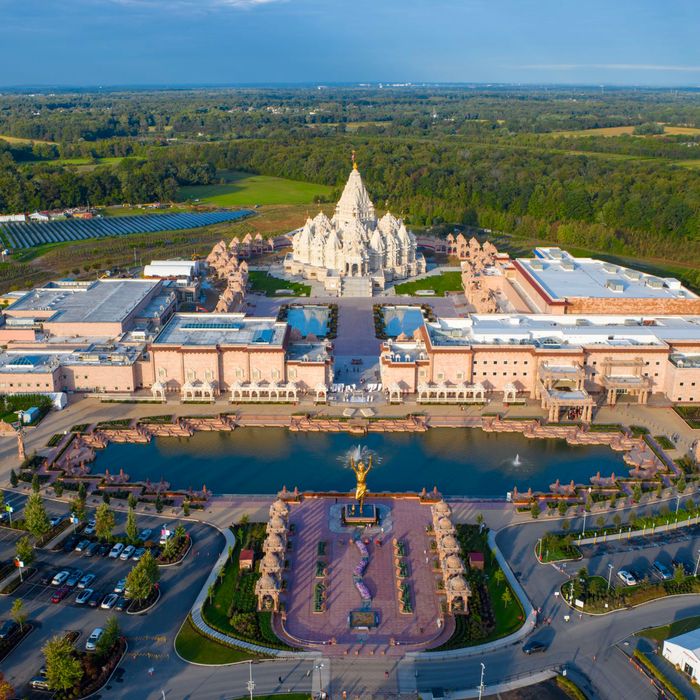
The path to God runs down the New Jersey Turnpike. About an hour from the Holland Tunnel, take a right off Route 130 after the Dunkin’, file into a stadium-size parking lot, and, just past the electric pylon, a mirage appears: a bronze statue of a skinny yogi and, beyond it, swirls of stone fluffed up into meringue peaks. I join the throngs walking from their cars to those surreal landmarks and find myself in a festive plaza. In the center is a large shallow stepwell of the kind that some Hindus use for ceremonial bathing (although the water is off-limits here). Families cluster around great stone bowls, burning incense and chanting prayers. Groups of various hues and languages amble around the plaza, taking pictures as if they had just disembarked from a cruise ship. In this suburban stretch of central New Jersey, where the second-most-palatial structure around is a car dealership, the town of Robbinsville improbably boasts the largest Hindu temple in the Western Hemisphere.
My guide through this dazzling sacred landscape is Yogesh Patel, a slim New Jerseyan in an uncreased bottle-green kurta. Recently, Patel put his career as a lawyer for financial institutions on hold to become a full-time volunteer. “My 5-year-old said I had to do this,” he explains.
Patel was raised in the Swaminarayan faith, a Hindu sect that has been growing in both influence and numbers and is managed by the organization Bochasanwasi Akshar Purushottam Swaminarayan Sanstha, based in the Indian state of Gujarat. In the past few decades, BAPS has gone on a worldwide building spree, inaugurating immense and ornate centers in the suburbs of Atlanta, Toronto, Houston, London, Nairobi, and many other places around the world. The mandir, or temple, in Robbinsville opened in 2014, but the rest of the campus, including a new multi-peaked mahamandir (megatemple), has just been completed; construction continues here and there. The expanded Akshardham—the term means “God’s abode”—is among the most imposing Hindu temples anywhere, and even outbulks BAPS’s Delhi location, which opened in 2005.
Patel and I start our tour beneath the great bronze figure of the late-18th and early-19th-century ascetic Swaminarayan, whose following eventually grew into a sect that worships him as a manifestation of God. The statue shows him as a teenage yogi (called Neelkanth Varni then; he had a lot of names) standing on one leg in a variation on half-lotus-tree pose, arms raised to the sky. “In this yogic posture, he stood for months, in the colds of the Himalayas, to show what is possible by the human body if we fix ourselves to a certain goal,” Patel says. (The statue is 49 feet high, one for each year of Swaminarayan’s life.) That high-altitude endurance test was just one stop on the boy’s 7,500-mile journey, which is traced on a 3-D map near the campus entrance and which visitors reproduce in miniature by following a pathway that winds past a pink sandstone arcade, each arch topped with a multilayered peak like a mini-Himalaya.
There’s little hint of austerity on the rest of the campus. As we approach the main temple, its nubbly exterior resolves into a white expanse of sculpted figures swaying, praying, holding yoga poses. Somewhere in this profusion, dancers are shown executing all 108 poses of the ancient tradition Bharatanatyam, and 151 musicians are playing sitars, sarods, tablas, and an orchestra’s worth of other instruments. Every inch of surface area is covered by astrological symbols, narrative reliefs, elephants, botanical motifs — a visual catalogue of Hinduism, conceived by someone who abhors blankness. The density of detail continues as we join the procession of visitors who file through the temple, passing by shrines and beneath shimmering domes. I look on the wall above my head and catch a sculpture of the toddler Krishna, face contorted, mouth agape; his mother, trying to scoop dirt out of his mouth, glimpses the universe at the back of his throat. I sympathize: Wherever my eye falls, there’s another cosmic story to read, another divinity to grasp. This is architecture to be experienced over time — preferably lots of time.
The new limestone and marble mahamandir, or great temple, every inch covered in sculpture.
The stepwell fountain, filled with water from 300 sources.
The pink sandstone arcade bordering the plaza, where the faithful walk, reproducing Swaminarayan’s journey in miniature.
The new limestone and marble mahamandir, or great temple, every inch covered in sculpture.
The stepwell fountain, filled with water from 300 sources.
The pink sandstone arcade bordering the plaza, where the faithful walk, reproducing Swaminarayan’s journey in miniature.
The meaning of this overload depends on whom you ask. To Samuel Parker, an art historian and anthropologist who specializes in contemporary Hindu temples, it represents the nearly infinite number of earthly forms that the one god, Brahman, can take. In that, it is hardly unique. Hindu temple architecture often expresses the relationship between that eternal divinity and its many manifestations. Its pinnacle reaches upward to channel the beam of energy that drops from the sky and then flows horizontally in all directions. Architecture radiates into landscape. A singular, abstract force bursts into a plethora of sculptural figures. The variety of specific forms mean that worshippers can find their preferred deity to pray to, concentrating the vast religious diversity of Hindu life into a centralized complex.
The principles of temple building were codified long ago: The Vastu Shastra lays out instructions for how to select a site, position the mandir in the landscape, build up a structure out of layers, and define its shape. The Shilpa Shastra dictates the rules of arts and crafts, including sculpture. Those documents have led to a great variety of interpretation and style, but the BAPS swamis — some of whom have technical degrees and designed the temple in conjunction with volunteer professionals and hired consultants — pride themselves on grounding every detail and measurement in ancient text. The Robbinsville temple is “part of a trend toward including more and more of the diverse, complex forces of nature in one monument. Rather than make long pilgrimages through the countryside to various sites, the temple offers multiple shrines all within a short walking distance at the same site. Structurally and visually, the effect can be overwhelming,” Parker says. “That’s the point.”
Parker finds that solidity comes at the cost of liveliness. Divinities are changeable; their physical embodiments should represent that mutable energy. “The perpetual challenge to artists in this tradition has been to try to make static materials appear as if they are alive — as if in the process of emanating into being,” Parker says. He finds the Robbinsville sculptures “stiff and mechanical, carved according to a precise iconographic formula, but without any apparent effort to capture the qualities of breath.” Even so, the result is a formidable combination of antiquity and novelty and, unlike just about every other building for miles around, this one is meant to last for centuries — or at least look as though it will.
Patel explains the temple’s size and richness differently. It should be big enough, he says, to receive all seekers and help any Hindu, of any persuasion, feel comfortable there. He tells me that the pool outside is filled with sacred waters from 300 sources (including all 50 U.S. states), meant to symbolize Hinduism’s openness to the world. “There’s a Vedic hymn that says, ‘Let good thoughts come from all directions.’ Anything that’s good from any religion or culture is something we want to accept and realize. And whoever wants to come to find their own spiritual path is welcome here.”
That multiplicity is reflected in the stones themselves, which emerged from the earth of many lands to travel farther even than the young Swaminarayan did. The plaza’s perimeter arcade is made of pink sandstone from the Indian state of Rajasthan, the main temple structure is built up out Bulgarian limestone (with a hidden concrete shell to meet seismic code), and the interior is lined with three flavors of marble: ultrawhite Greek, like blocks of polished feta; sculptures carved out of Carrara; and darker supporting slabs of dense Turkish stone. (Some sections of the interior are faced in glass-reinforced gypsum, or GRG, which is cast rather than carved.) The mountains of premium rock were shipped first to Rajasthan, where thousands of craftsmen used chisel and hammer and ageless technique to extract the loose-limbed god within each block.
“Their forefathers built the ancient temples in India. The artistry they possess is not something you could learn from school — it’s passed on from generation to generation,” Patel says. Chunk by chunk, the temple was shipped to New Jersey and assembled by what BAPS describes as an army of 12,500 volunteers — people from all over this country and a corps of workers brought in from India. The process yielded a litany of numbers: a 185-acre complex, a dozen years of construction, a 189-foot peak, and 10,000 sculptures. It is a triumph of logistics and collective effort.
Given the temple’s Ozymandian magnificence, the construction budget of $96 million seems like a steal. The key to making the project work, at least according to BAPS’s account, was an enormous, mostly free workforce. That’s how you build an immense, ultrafantastical temple in a New Jersey suburb: gather an army of volunteers — or recruit workers willing to accept a pittance. It appears the temple may have done both. Many devotees say they were glad to help because construction gave them a precious opportunity to practice seva, the selfless service that is at the core of Hinduism. “I do not feel as if I am providing my time or energy toward a cause, rather I have been gaining things from performing seva,” a volunteer stonemason, Mauktik Dave, wrote in a blog post. They came from all over, some for a few days, others for years, to do jobs they first had to learn. They worked in like-minded groups, ate meals on site prepared by other volunteers, and acquired skills they probably never thought they’d need. They practiced humility and emulated their guru’s life of service.
Yogen Solanki, a young architectural designer who spent his early years in New Jersey before moving with his family to the Midwest, took two weeks off from his job at Design Collaborative in Fort Wayne, Indiana, to mix the grout that holds the granite pavers. He says it was one of the best decisions he has ever made. “I take pride in the fact that I helped build this temple, that my hands have placed a piece of stone. I was part of something that was so much bigger than myself.” He was, he says, helping to build his own moral home. “Growing up in an area with so much diversity, the temple was always my place. It allowed me to be who I am. This was how I was going to be a good person. Hinduism is a religion of love and humility. It’s a collectivistic culture, and I was drawn to that.”
That kind of devotion, multiplied by BAPS’s million-plus adherents, can make an irresistible political and economic force. Like all great religious structures, the Akshardham projects worldly power. Ipsita Chatterjee, a geography professor at the University of North Texas who wrote about BAPS’s American Akshardhams in Spectacular Cities: Religion, Landscape, and the Dialectics of Globalization, focuses on the financial side of spirituality. “The whole point of the spiritual discourse is austerity and renunciation. The god Swaminarayan is shown bare-chested, wearing a dhoti. But in the temple, the move away from materialism is displayed through materialistic splendor.”
The tension between humility and opulence has legal ramifications, too. BAPS says that the army of self-sacrificing volunteers includes a corps of specialist artisans from India who arrived in New Jersey on temporary religious visas. In a lawsuit filed in 2021, some of those workers, who reportedly turned out to be mostly low-caste Dalits, complained that overseers had confiscated their passports, lodged them in trailers on the site, forced them to work long hours, and paid them wages that were far below American standards. The case triggered a Federal raid and an investigation into the kind of labor practices that are common on construction sites in many parts of the world — and were probably the norm for the great ancient temples. (BAPS disputes the lawsuit’s accusations — and notes that 12 of the 21 workers who filed the complaint subsequently pulled out of the suit.) “The elites volunteer to be recorded on a video camera for marketing purposes, but they don’t do the heavy lifting,” Chatterjee says. “In India, temples have always been built by poor rural people who work under semi-slavery conditions.” Disguising migrant laborers as volunteers would likely be a violation of both labor and immigration laws, though. A federal court may soon determine whether an organization dedicated to service and spirituality was in fact exploiting those who built its heaven on earth.
For Chatterjee, the scale and splendor of BAPS’s major temples reflects the organization’s temporal ambitions more than its spiritual aspirations. She points out that general donations are supplemented with prices for certain rituals. A BAPS spokesperson says that tiered systems of giving are common across religious denominations around the world. But the Robbinsville temple’s website includes a menu that is remarkably steep and highly specific: To make what’s called a mahapuja offering of fruits and garlands, a worshiper is asked to shell out $101. More elaborate rituals that involve adorning a godly statue can top $1,501. “Every kind of interaction with God is monetized, and so is every other aspect, like the overpriced food and gift-store items. You don’t often see the flow of wealth so unabashedly exposed,” Chatterjee says.
Less visible in this country is BAPS’s resourcefulness in maximizing nonspiritual revenue streams. The temple in New Delhi sells separate tickets to a movie theater showing Neelkanth Yatra, the story of the boy yogi’s seven-year trek (“Shot at 108 different locations, a cast of more than 45,000,” the numbers-obsessed website notes); a mechanized boat ride through 10,000 years of Indian history (inspired by the swamis’ visits to Disneyland and Universal Studios); a set of high-tech dioramas in the Hall of Values (animatronic nonviolence!); and a Bellaggio-esque musical fountain. The theme-park attractions are absent from the American temples, presumably because here they would seem less special than a profusion of carved deities. BAPS’s swamis know their audience both in India and the U.S., Chatterjee says: “They import modernity and export antiquity.”
The bronze statue of the teenaged Swaminarayan standing in the Himalayan snows.
The elaborately carved interior of the mahamandir includes shrines to various gods.
A few of the 151 stone performers playing silent music.
The bronze statue of the teenaged Swaminarayan standing in the Himalayan snows.
The elaborately carved interior of the mahamandir includes shrines to various gods.
A few of the 151 stone performers playing silent music.
Sanjay Srivastava, an anthropologist at SOAS University of London, suggests that the Akshardhams are designed as much for public relations as for spiritual elevation. “It’s an architecture that makes Hinduism into a white-collar religion,” he says. “All those numbers — so many acres, so many cubic feet of stone, so many feet high — translate into a language of global respectability. They’ve invented a particular kind of Hinduism that aspires to be taken seriously by the non-Hindu world.” Shriya Sridharan, who teaches a course on the Hindu temple in its global forms at Santa Clara University, adds that the sect has three constituencies to satisfy: its followers, non-Swaminarayan Hindus, and non-Hindus. “In the diaspora, Hindus are willing to connect to this form, even though it’s not part of their regional tradition. It’s a representative of Hinduism that can be transferred globally.”
To Srivastava, the Robbinsville temple represents one more outpost of an expansionary organization whose spread is powered by a complicated mixture of politics, economics, class, history, and practical spirituality. The Swaminarayan sect has deep roots in Gujarat, the home region of Mahatma Gandhi, Prime Minister Narendra Modi, and an affluent global diaspora that includes a sizable chunk of the hospitality industry in the United States. (Reportedly, Indian Americans own more than 40 percent of this country’s motels, and 70 percent of those are Gujaratis, many with the surname Patel.) Many from that class of well-off expats send money back to India in the form of “saffron dollars,” donations to Modi’s right-wing governing party, the BJP — and also to BAPS, Srivastava says. In exchange, the organization erects symbols of success, tradition, and cultural pride.
In India, Modi and the BJP have espoused the ideology known as Hindutva, a version of Indian national identity that subordinates the subcontinent’s ethnic and religious diversity into a narrative of Hindu supremacy. Modi referred to BAPS’s late leader, Pramukh Swami Maharaj, as his father figure and claimed to have signed the candidacy papers for every election he ran in with pens sent by the swami. When the sect wanted to build its main temple on a stretch of ecologically sensitive riverbank in Delhi, the government made the deal happen. The swami’s clout extended beyond India: When he died in 2016, President Obama sent a message of tribute. It was Pramukh Swami Maharaj who envisioned using spectacular architecture to expand the sect’s footprint abroad. The Robbinsville temple’s dedication ceremony on October 8 realized his most sweeping vision, merging the qualities of a Bollywood extravaganza and an Olympic opening, with hundreds of costumed dancers spread out over a plaza illuminated with multicolored LEDs.
You might also see the Akshardham as a counterweight to the material temptations of American culture. The vastness of the site, the height of the tower, the wall-to-wall scrimmage of sculptures, the sheer bulk of creamy marble rising over above the suburban flatlands of New Jersey — all of it beams a Bat signal to Hindus eager to reconcile prosperity with the fear of losing their culture in an assimilationist country. The temple is not just a place of worship; it’s also a social magnet, a cultural conservation society, a mechanism for protecting the integrity of young Indians’ dating pool, a way of winning the next generation’s affections, and a medium with which to broadcast the home country’s glories to the outside world. Evidently, part of the temple’s mission is to pry the American-born children of immigrants away from the mall, the bedroom, and the wonders of their video worlds. That’s why the Akshardham must be vaster, brighter, cleaner, and more sumptuous than any structure those kids have ever seen.
This temple that emulates the past and asserts itself in the complicated sectarian now is also a long-shot bet on the future. Gujaratis have migrated again and again, to East Africa, the U.K., and everywhere in this country there’s a roadside motel. If, one day, they or the rest of the Indian American community disperse, cluster elsewhere, or lose their religion over the course of generations, then the Robbinsville Akshardham will meet the fate of so many urban churches: It will outlast its faithful and overtax their generosity, turning into a gigantic white elephant encrusted with smaller white elephants in the middle of an exurban field.











